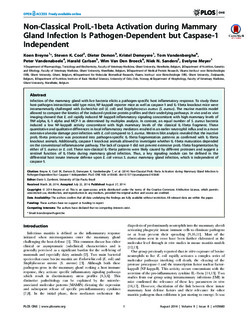| dc.description.abstract | Infection of the mammary gland with live bacteria elicits a pathogen-specific host inflammatory response. To study these
host-pathogen interactions wild type mice, NF-kappaB reporter mice as well as caspase-1 and IL-1beta knockout mice were
intramammarily challenged with Escherichia coli (E. coli) and Staphylococcus aureus (S. aureus). The murine mastitis model
allowed to compare the kinetics of the induced cytokine protein profiles and their underlying pathways. In vivo and ex vivo
imaging showed that E. coli rapidly induced NF-kappaB inflammatory signaling concomitant with high mammary levels of
TNF-alpha, IL-1 alpha and MCP-1 as determined by multiplex analysis. In contrast, an equal number of S. aureus bacteria
induced a low NF-kappaB activity concomitant with high mammary levels of the classical IL-1beta fragment. These
quantitative and qualitative differences in local inflammatory mediators resulted in an earlier neutrophil influx and in a more
extensive alveolar damage post-infection with E. coli compared to S. aureus. Western blot analysis revealed that the inactive
proIL-1beta precursor was processed into pathogen-specific IL-1beta fragmentation patterns as confirmed with IL-1beta
knockout animals. Additionally, caspase-1 knockout animals allowed to investigate whether IL-1beta maturation depended
on the conventional inflammasome pathway. The lack of caspase-1 did not prevent extensive proIL-1beta fragmentation by
either of S. aureus or E. coli. These non-classical IL-1beta patterns were likely caused by different proteases and suggest a
sentinel function of IL-1beta during mammary gland infection. Thus, a key signaling nodule can be defined in the
differential host innate immune defense upon E. coli versus S. aureus mammary gland infection, which is independent of
caspase-1. | nb_NO |

